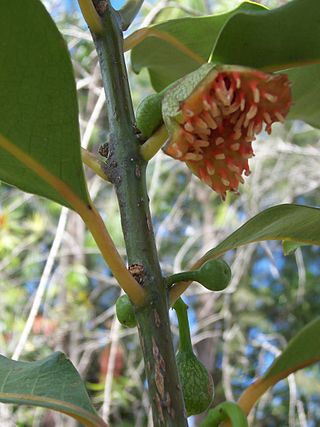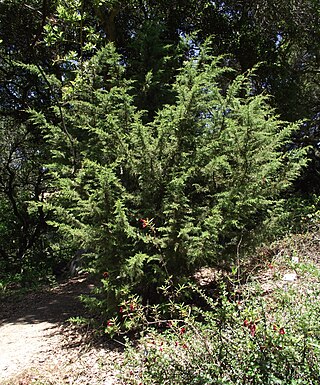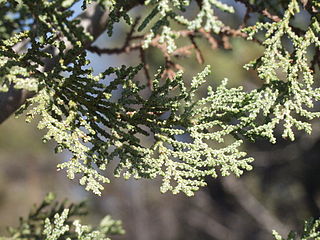
The Monimiaceae is a family of flowering plants in the magnoliid order Laurales. It is closely related to the families Hernandiaceae and Lauraceae. It consists of shrubs, small trees, and a few lianas of the tropics and subtropics, mostly in the southern hemisphere. The largest center of diversity is New Guinea, with about 75 species. Lesser centres of diversity are Madagascar, Australia, and the neotropics. Africa has one species, Xymalos monospora, as does Southern Chile. Several species are distributed through Malesia and the southwest Pacific.

Hesperocyparis arizonica, the Arizona cypress, is a North American species of tree in the cypress family Cupressaceae, native to the southwestern United States and Mexico. Populations may be scattered rather than in large, dense stands.

Hesperocyparis goveniana commonly known as Californian cypress and Gowen cypress, is a species of western cypress that is endemic to a small area of coastal California near Monterey. It was formerly classified as Cupressus goveniana.

Hesperocyparis guadalupensis, commonly known as Guadalupe cypress, is a species of western cypress from Guadalupe Island in the Pacific Ocean off the western coast of Mexico's Baja Peninsula. It was previously known as Cupressus guadalupensis.

Dysoxylum is a genus of rainforest trees and shrubs in the flowering plant family Meliaceae. About 34 species are recognised in the genus, distributed from India and southern China, through southeast Asia to New Guinea, Solomon Islands, and Australia. The name Dysoxylum derives from the Greek word ‘Dys’ meaning "bad" referring to "ill-smelling" and ‘Xylon’ meaning "wood".

Melastoma affine, also known by the common names blue tongue or native lassiandra, is a shrub of the family Melastomataceae. Distributed in tropical and sub-tropical forests of India, South-east Asia and Australia, it is a plant of rainforest margins. Bees are the principal pollinators of this species.

Diploglottis is a genus of 11 species in the lychee and maple family Sapindaceae. Most species only occur in the Wet Tropics bioregion of Queensland, but all species except one are endemic to eastern Australia, with the exception being D. diphyllostegia, which also occurs in New Guinea. They are commonly called tamarinds, for example northern tamarind, Babinda tamarind and Bernie's tamarind, however they are not closely related to the true tamarind from the family Fabaceae.

Hesperocyparis macnabiana is a species of western cypress in from California that was previously named Cupressus macnabiana.

In taxonomy, an undescribed taxon is a taxon that has been discovered, but not yet formally described and named. The various Nomenclature Codes specify the requirements for a new taxon to be validly described and named. Until such a description has been published, the taxon has no formal or official name, although a temporary, informal name is often used. A published scientific name may not fulfil the requirements of the Codes for various reasons. For example, if the taxon was not adequately described, its name is called a nomen nudum. It is possible for a taxon to be "undescribed" for an extensive period of time, even if unofficial descriptions are published.

Cupressus sargentii is a species of conifer in the family Cupressaceae known by the common name Sargent's cypress. It is endemic to California, where it is known from Mendocino County southwards to Santa Barbara County. This taxon is limited to the Coast Range mountains. It grows in forests with other conifers, as well as chaparral and other local mountain habitat, usually in pure stands on serpentine soils. It generally grows 10 to 15 meters tall, but it is known to exceed 22 meters. On Carson Ridge in Marin County, as well as Hood Mountain in Sonoma County, the species comprises a pygmy forest of trees which do not attain heights greater than 240–360 cm due to high mineral concentrations in the serpentine soil.

Satranala decussilvae is a species of flowering plant in the Arecaceae family. It is a palm endemic to Madagascar. It is the only species in the genus Satranala, and is threatened by habitat loss. There are perhaps 200 mature individuals remaining.

Hesperocyparis glabra, known as the Arizona smooth bark cypress or smooth Arizona cypress, is a conifer native to the American Southwest, with a range stretching over the canyons and slopes in a somewhat wide vicinity around Sedona, Arizona. It is distinguished from Hesperocyparis arizonica by its very smooth, non-furrowed bark which can appear in shades of pink, cherry, and grey.

Wilkiea is a genus of dioecious trees and shrubs in the Mollinedieae tribe of the family Monimiaceae. They grow in eastern Australia and New Guinea. Species mostly have toothed leaves with short leaf stems and many oil dots on the leaves. The genus appears to have an Australian or southern origin.

Palmeria is a genus of flowering plant in the family Monimiaceae. Its range includes Sulawesi, New Guinea, the Bismarck Archipelago, and Australia.
× Sorbaronia is a hybrid genus of flowering plants belonging to the family Rosaceae. The hybrids are between species of Sorbus and Aronia. It is native to Eastern Canada. In addition, × Sorbaronia fallax has been created artificially.
Pternandra is a genus of trees in the Melastomataceae family. There are 17 species in the taxa. It is native to an area from northern Australia through Southeast Asia to Hainan, Zhōngguó/China and India. The botanist William Jack who named the taxa, died at 27 years of age, the year his description was published.
Ashleigh Whiffin is an entomologist in the UK. She is a curator at the National Museum of Scotland and a specialist in carrion beetles (Silphidae).
Steganthera is a genus of flowering plants belonging to the family Monimiaceae.
Hemmantia is a monotypic genus of flowering plants belonging to the family Monimiaceae. The only species is Hemmantia webbii.
Pilocosta is a genus of flowering plants belonging to the family Melastomataceae. Its native range is Costa Rica to Ecuador.














